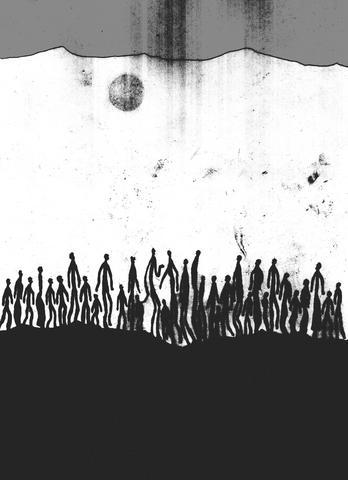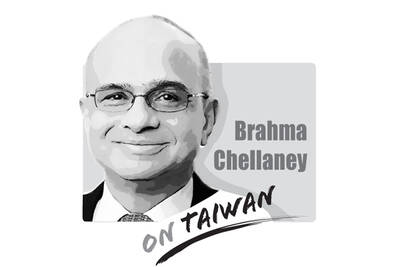Imad Zaid, unemployed and desperate, spends his days at an Internet cafe, e-mailing friends in Europe for help in escaping his virtually walled-in town.
About 10 percent of Qalqiliya's 40,000 people have left during the past three years of Israeli-Palestinian fighting, the mayor's office says, either to go abroad or move deeper into the West Bank.
The flight from Qalqiliya mirrors migration patterns across the territory and to a lesser extent in the Gaza Strip.

ILLUSTRATION: MOUNTAIN PEOPLE
Thousands have moved to other towns to avoid the hardships of living too close to army checkpoints and battle zones. There are also signs that thousands more have gone abroad, mostly to Europe, Persian Gulf states and the US.
Jordan last week made the migration threat the focus of its argument before the world court against Israel's separation barrier in the West Bank, saying it is making life so miserable that many West Bankers might seek refuge in the neighboring kingdom and overwhelm already strained social services.
Israel says the barrier is meant to keep out attackers who have killed 930 people. Palestinians call it a land grab.
Jordan is enforcing restrictions on Palestinian visitors to stem the influx. Israeli and Jordanian border officials say they don't have emigration figures. However, anecdotal accounts, estimates by human rights groups and surveys point to a worrying flight of students and professionals going abroad.
The number of applications for asylum in Sweden, a popular destination, was about 1,600 last year, more than triple the 2001 number, Swedish immigration officials say.
Palestinian officials tend to play down the scope of migration.
Many Palestinians consider emigration a betrayal of statehood aspirations -- a taboo dating back to the 1948 Mideast war over Israel's creation when hundreds of thousands of Palestinians fled or were driven out. The exodus is referred to as al naqba, or the catastrophe.
Qalqiliya Mayor Marouf Zahran said those who move are often too embarrassed to show up at City Hall to have their electricity shut off. Others tell neighbors they're just making a quick trip to Jordan or are going abroad for medical treatment.
"Those who left their land are not respected in the eyes of the community," said Zahran.
"People do it ... quietly," he said.
The war that has killed 2,688 people on the Palestinian side has also ruined the economy and driven unemployment to 70 percent in some areas. There's also crushing boredom left in the trail of curfews and travel restrictions, along with bleak prospects for statehood.
"So many Palestinians have become completely hopeless on their future," said Palestinian human rights activist Bassem Eid.
Zaid, 31, the unemployed Qalqiliya man, said that last year he tried to settle in Germany and Switzerland but was turned away. Now he has set his sights on Denmark, where his father fled as a young man after Israel captured the West Bank in the 1967 Mideast war.
The younger Zaid lived in Denmark until age 6 when his family returned to the West Bank, but he never became a citizen.
"Since we are living in a prison here in the West Bank, we look for work and freedom abroad," said Zaid, who can no longer find even odd jobs in town and is just killing time.
Qalqiliya was once an important commercial hub in the northern West Bank, with farms and dozens of lucrative joint businesses with Israel.
But the exodus began two years ago, when Israel started sealing off Qalqiliya.
Israel recently loosened restrictions on movement in and out of the town.
Elsewhere, army checkpoints disrupt commutes, forcing Palestinians to stay in the cities where they work.
Migrants moving to Ramallah, the West Bank's business and government hub, have left wives and children behind in other towns. Rents have almost doubled, to an average of US$500 a month. Many newcomers live together in groups of five or six. They line up at banks to send money home to their families.
About 15,000 Palestinians have fled the Israeli-controlled center of the West Bank city of Hebron, the Israeli human rights group B'tselem says. Another 5,000 have moved from Gaza's battle-scarred south to Gaza City, local police say.
In Beit Sahour, a predominantly Christian suburb of Bethlehem, more than 450 people have left the community of 12,000, said town chronicler Ghassan Andoni. Many have gone abroad.
The move is easiest for hundreds of thousands who already carry foreign passports or have relatives abroad, as a result of previous emigration waves. Some 40,000 West Bankers hold US citizenship.
George Qassis, 29, who lost his job at the luxury Intercontinental Hotel in Bethlehem at the start of fighting, moved to Toms River, New Jersey, after a major Israeli military offensive in 2002. Despite a master's degree from a German university, he now pumps gas and sells olive wood carvings.
"Of course I'm planning to come back. But I don't know when," Qassis said.
At Ramallah's Bir Zeit University, students say there are few opportunities for the educated. Architecture student Moayed al-Zour, 23, said he hopes to join relatives in Saudi Arabia. Art student Tareq Rantisi, 19, said he'd likely go back to the US, where his sister lives.
Palestinian Foreign Minister Nabil Shaath said he believed the numbers of those leaving are small, but that the exodus poses a threat.
"What we have is the emigration of minds, and this is the most dangerous," Shaath said, "because we need those people to build the Palestinian state."

As strategic tensions escalate across the vast Indo-Pacific region, Taiwan has emerged as more than a potential flashpoint. It is the fulcrum upon which the credibility of the evolving American-led strategy of integrated deterrence now rests. How the US and regional powers like Japan respond to Taiwan’s defense, and how credible the deterrent against Chinese aggression proves to be, will profoundly shape the Indo-Pacific security architecture for years to come. A successful defense of Taiwan through strengthened deterrence in the Indo-Pacific would enhance the credibility of the US-led alliance system and underpin America’s global preeminence, while a failure of integrated deterrence would
It is being said every second day: The ongoing recall campaign in Taiwan — where citizens are trying to collect enough signatures to trigger re-elections for a number of Chinese Nationalist Party (KMT) legislators — is orchestrated by the Democratic Progressive Party (DPP), or even President William Lai (賴清德) himself. The KMT makes the claim, and foreign media and analysts repeat it. However, they never show any proof — because there is not any. It is alarming how easily academics, journalists and experts toss around claims that amount to accusing a democratic government of conspiracy — without a shred of evidence. These
Taiwan is confronting escalating threats from its behemoth neighbor. Last month, the Chinese People’s Liberation Army conducted live-fire drills in the East China Sea, practicing blockades and precision strikes on simulated targets, while its escalating cyberattacks targeting government, financial and telecommunication systems threaten to disrupt Taiwan’s digital infrastructure. The mounting geopolitical pressure underscores Taiwan’s need to strengthen its defense capabilities to deter possible aggression and improve civilian preparedness. The consequences of inadequate preparation have been made all too clear by the tragic situation in Ukraine. Taiwan can build on its successful COVID-19 response, marked by effective planning and execution, to enhance
Since taking office, US President Donald Trump has upheld the core goals of “making America safer, stronger, and more prosperous,” fully implementing an “America first” policy. Countries have responded cautiously to the fresh style and rapid pace of the new Trump administration. The US has prioritized reindustrialization, building a stronger US role in the Indo-Pacific, and countering China’s malicious influence. This has created a high degree of alignment between the interests of Taiwan and the US in security, economics, technology and other spheres. Taiwan must properly understand the Trump administration’s intentions and coordinate, connect and correspond with US strategic goals.